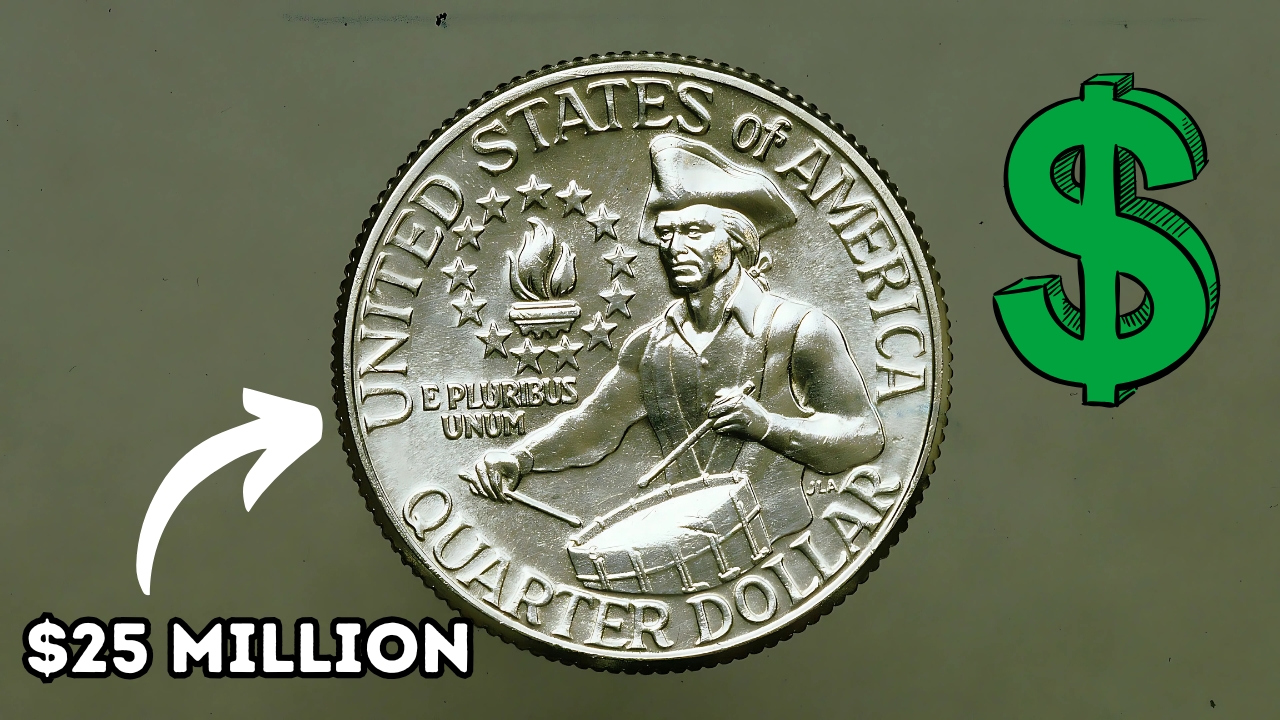Rare Bicentennial Quarter : Tucked away in the cash registers, coin jars, or even in that pocket of yours might be one of the most astonishing finds in modern numismatics—a particular type of Bicentennial quarter that could be worth an astounding $25 million!
This is not just a dramatic claim; it represents the actual worth of an incredibly rare minting mistake that has remained elusive for collectors and may be circulating casually in everyday transactions throughout the United States.
The United States Mint crafted Bicentennial quarters from 1975 to 1976 to celebrate America’s 200th year of independence.
These commemorative quarters showcased a colonial drummer on the reverse side with dual dates (1776-1976) prominently displayed on the obverse.
With over 1.7 billion of these quarters struck, they are fairly common in circulation even today.
However, among these billions lies a rare variant—one so unusual that only a handful is believed to exist, with just one confirmed example in the numismatic world.
The $25 Million Error: What Makes It Unique
This exceptionally valuable coin emerged from what experts label a “double-die obverse” paired with an overdate error specific to the Bicentennial series.
To put it simply, the die used to mint the coin was mistakenly struck twice at slightly different angles during production, resulting in a slight doubling effect that’s most apparent on Washington’s profile, especially around the date and lettering.
What elevates this particular error coin far above other double-die quarters is a unique combination of elements:
-
The error is specific to the unique Bicentennial design
-
The visible doubling is most pronounced on the dual dates (1776-1976)
-
The coin was struck on a copper-nickel planchet, not silver
-
The error emerged from the Philadelphia Mint (which carries no mint mark)
As stated by Lawrence Shepherd, a well-known numismatics expert with a focus on American coinage, “This coin represents the perfect storm of error circumstances.”
“You have a commemorative design with historical relevance combined with a significant minting mistake that somehow passed quality control at a time when coin collecting was in the spotlight.”
The Challenges of Verification and Authentication
The overwhelming value attributed to this rare error has posed considerable hurdles for authentication.
While many collectors assert they have found this rare quarter, nearly all examples evaluated professionally have turned out to be either altered coins or instances of machine doubling—an artifact of manufacturing that’s similar but distinct from a true double-die error.
The Professional Coin Grading Service (PCGS) and Numismatic Guaranty Corporation (NGC), recognized leaders in coin authentication, maintain rigorous protocols for validating prospective finds.
Their methods involve sophisticated microscopy and comparative assessments against established characteristics of the authenticated example.
Maria Santiago, a senior authenticator at PCGS, remarks, “We evaluate hundreds of Bicentennial quarters every year from hopeful owners. The genuine quarter displays unique doubling traits that can’t be replicated through any post-mint alteration.”
“The doubling is most apparent on the ‘776’ in the dual date and maintains a consistent elevation across the affected elements.”
The Quest Continues: Rare Bicentennial Quarters in Circulation
The intriguing part of this tale is that further instances of this ultra-rare error could still be out there, mingling in daily transactions.
Unlike many valuable coins that were swiftly pulled from circulation due to their silver makeup or distinct visual characteristics, the Bicentennial quarter error looks strikingly similar to standard quarters at a casual glance.
Coin roll hunters—enthusiasts who sift through bank-wrapped rolls of coins in search of valuable finds—have placed the Bicentennial quarter at the top of their target list.
Dedicated online communities have thousands of members who collectively review millions of quarters each year.
Robert Finkelstein, founder of the American Rare Coin Fellowship, notes, “Most valuable coins from the 20th century were removed from circulation long ago. This particular quarter might represent the last great ‘buried treasure’ that could be hiding in plain sight. Its value continues to rise due to its elusive nature and increasing collector passion.”
Recognizing the Rare Bicentennial Quarter: Key Features
For casual coin-hunters hoping to discover a numismatic gem, experts suggest looking for Bicentennial quarters with these distinctive features:
-
No mint mark, signifying it was minted in Philadelphia
-
Visible doubling on the date, especially the “776” section
-
Doubling observed on “LIBERTY” and “IN GOD WE TRUST”
-
Typical copper-nickel color (not silver)
However, experts emphasize that authentic confirmation necessitates professional evaluation.
With potentially astronomical values at stake, the market has regrettably seen many altered coins and outright fakes.
For many individuals, the search offers an exciting opportunity—your pocket change might just hold an unexpected fortune, making this a modern-day treasure hunt within reach for anyone willing to scrutinize their quarters closely.
